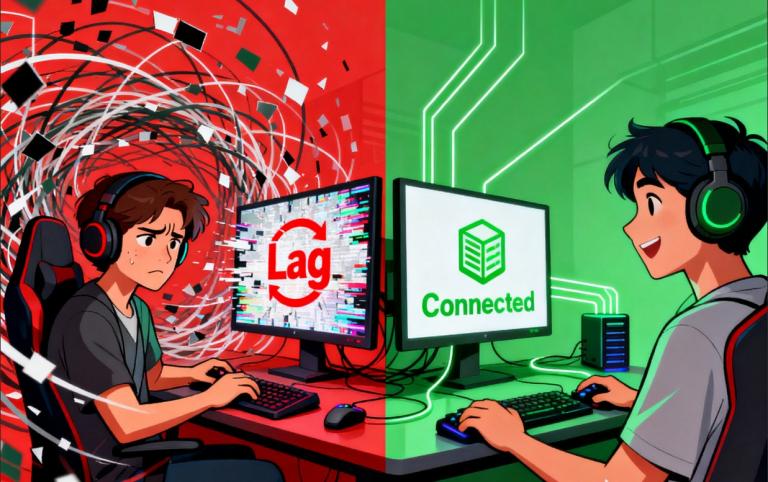
Remember the last time you were in the middle of an epic online battle, perfectly poised to land the final blow, when suddenly… everything froze? Your character stutters, the screen glitches, and by the time it all catches up, you’re staring at a "You Died" message. Your heart sinks. That moment of frustration—that gut-wrenching feeling of losing a fight that wasn’t even fair—is the single biggest enemy in online gaming. We’ve all been there, swearing at our router, our internet provider, or the game server itself. We blame the "lag," but do we really understand what it is and why it feels like such a personal attack? This isn’t just about a slow connection; it’s about a direct violation of our experience. It’s a sudden, jarring disruption that can turn a passionate player into an ex-fan.
For game developers and publishers, this is a crisis. Players don't just forget about a bad experience; they remember it, they complain about it on forums, and they warn their friends. And here's the confusing part: you can have a beautifully designed, meticulously coded game, but if the player’s experience is ruined by latency, all that hard work is for nothing. The problem isn’t the game; the problem is the vast, unpredictable network that connects players to it. It’s the digital equivalent of trying to have a conversation with someone on the other side of a crowded, noisy stadium—some of the words get through, but much of the context is lost, and the delay makes a real-time exchange impossible.
So, how do you solve a problem that isn’t even on your end? How do you guarantee a smooth experience for a player in a small town in Asia when your game servers are located in North America? This is where a Content Delivery Network (CDN) comes in, not as a simple solution, but as a total game-changer. It’s the invisible hand that takes that noisy stadium and transforms it into a whisper-quiet private room. It’s a profound shift that moves the focus from a centralized service to a personalized, localized experience.
The Unseen Battle: How CDN Tackles Latency
To truly understand how a CDN revolutionizes gaming, we have to talk about two things: static content and latency.
Static content is everything in a game that doesn't change in real time. Think about the textures of a character's armor, the environmental art, the sound effects, and the initial game updates. When you download a game, you're downloading massive amounts of this data. Without a CDN, every single player, no matter where they are in the world, has to pull all of this data from a single, centralized server. A gamer in Japan would have to connect to a server in California to get a texture file. That data travels thousands of miles, across multiple networks, through different internet service providers. Each hop adds a tiny bit of delay. Multiply that by millions of players all trying to do the same thing, and you've got a digital traffic jam of epic proportions.
A CDN completely changes this by creating a network of global "mini-warehouses." These are servers strategically located in key data centers all over the world. The static content from your game—all those art assets, files, and updates—is copied and stored on these edge servers. When a player in Tokyo wants to download a game update, the CDN’s intelligent routing sends their request to the closest server in Japan. That file, which once took minutes to travel across the ocean, now travels a few dozen miles in milliseconds. This is a crucial, foundational piece of the puzzle. It takes the game's massive content and brings it right to the player’s doorstep.
Beyond the Download: CDN for the Real-Time Experience
Okay, so a CDN makes downloads faster. That’s great. But what about the actual gameplay? That's all about real-time, dynamic data, right? This is where it gets really deep.
While the CDN can't host the core logic of a real-time multiplayer match—that still needs a central game server—it can do something else that’s just as important: accelerate the dynamic requests. Think of it as preparing the ground for the real fight. A CDN can optimize the paths that data packets take to and from the central server, bypassing congested routes and choosing the fastest path. This is especially vital for the authentication requests, API calls, and other backend communications that happen constantly during gameplay. A player's login data or in-game store request might still have to talk to the central server, but the CDN ensures that this communication channel is as clean and direct as possible. It’s like clearing a path through a jungle before the army arrives.
Furthermore, a high-performance CDN is crucial for patching and updates. We’ve all seen the dreaded "patch day" where a new update goes live, and the game’s servers immediately buckle under the weight of millions of simultaneous download requests. A CDN solves this problem beautifully. Instead of a single server trying to push out a massive 20GB update to everyone at once, the update is distributed across the CDN's global network. Players automatically download the patch from their closest server, ensuring a fast, stable download experience for everyone, everywhere. This smooths out the user journey from "frustrated by a download queue" to "excited to jump into the new content."
The Ultimate Transformation: From Frustration to Loyalty
So, how does all this technical wizardry translate into something as intangible as "loyalty"?
It's simple, really. It’s all about consistency and reliability. When a player logs in, they expect the game to work. They don't want to think about the technology behind it. They want to focus on the challenge, the strategy, and the fun. When they experience a game that consistently loads fast, updates quickly, and minimizes in-game lag, they subconsciously form a positive relationship with that brand. This positive feeling is the foundation of loyalty.
Think about the reverse. If a player is constantly interrupted by poor performance, they will get frustrated. They'll start looking for alternatives. They’ll see another game offering a smoother experience, and they'll likely switch. A CDN isn't just a technical solution; it's a retention strategy. By eliminating the friction and frustration caused by poor performance, you are removing the primary reason a player might leave. You are telling them, "We respect your time. We want you to enjoy your experience."
This is also a huge selling point for new players. In today's highly competitive market, first impressions are everything. A new player's initial experience of a game—from the download speed to the first few minutes of gameplay—will largely determine if they stick around. By leveraging a CDN, you're ensuring that their very first interaction with your game is a positive one, setting them up for a long and loyal relationship. It's the difference between a new acquaintance saying, "Wow, you're great," and "I don't think this is going to work out."
In the end, the most powerful thing a CDN does for a game is this: it makes the technology disappear. It takes the complex, frustrating reality of a global network and turns it into a seamless, uninterrupted experience. It replaces the sudden, jarring moments of latency with the smooth, consistent rhythm of an immersive game. The players aren't just buying your game; they're buying into an experience. And a high-performance CDN is the silent, essential force that makes that experience not just possible, but truly exceptional.

